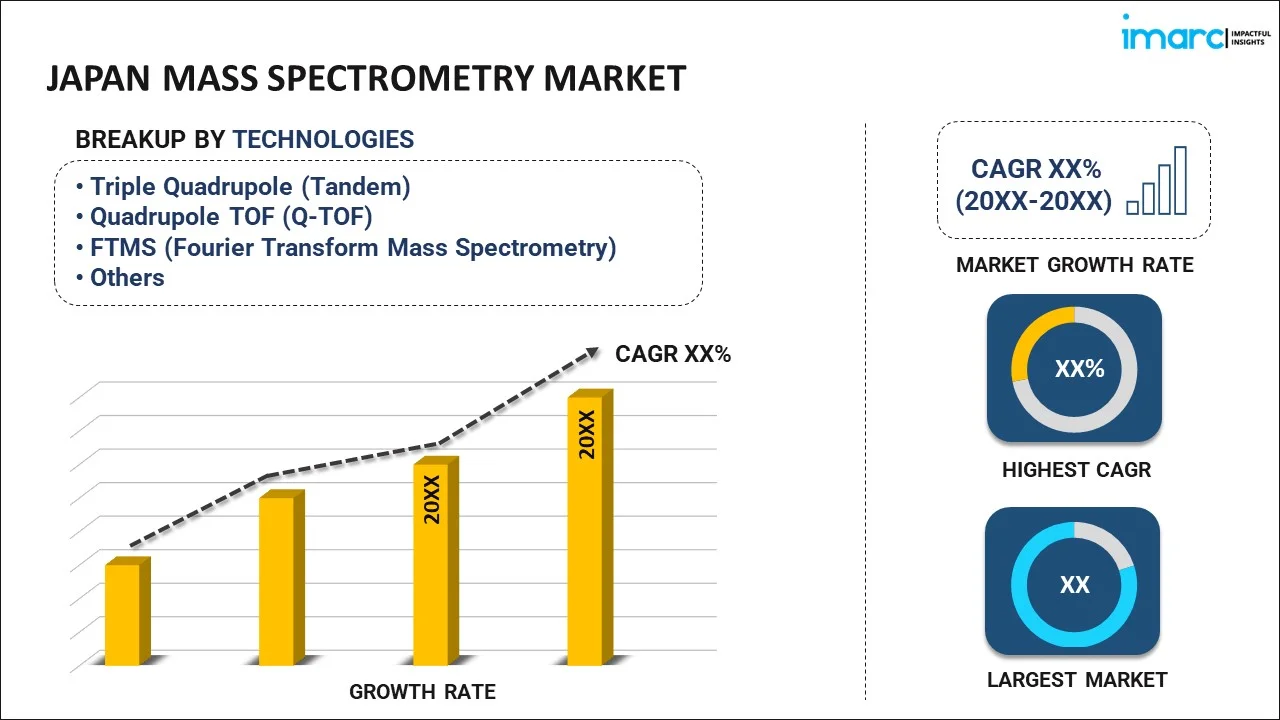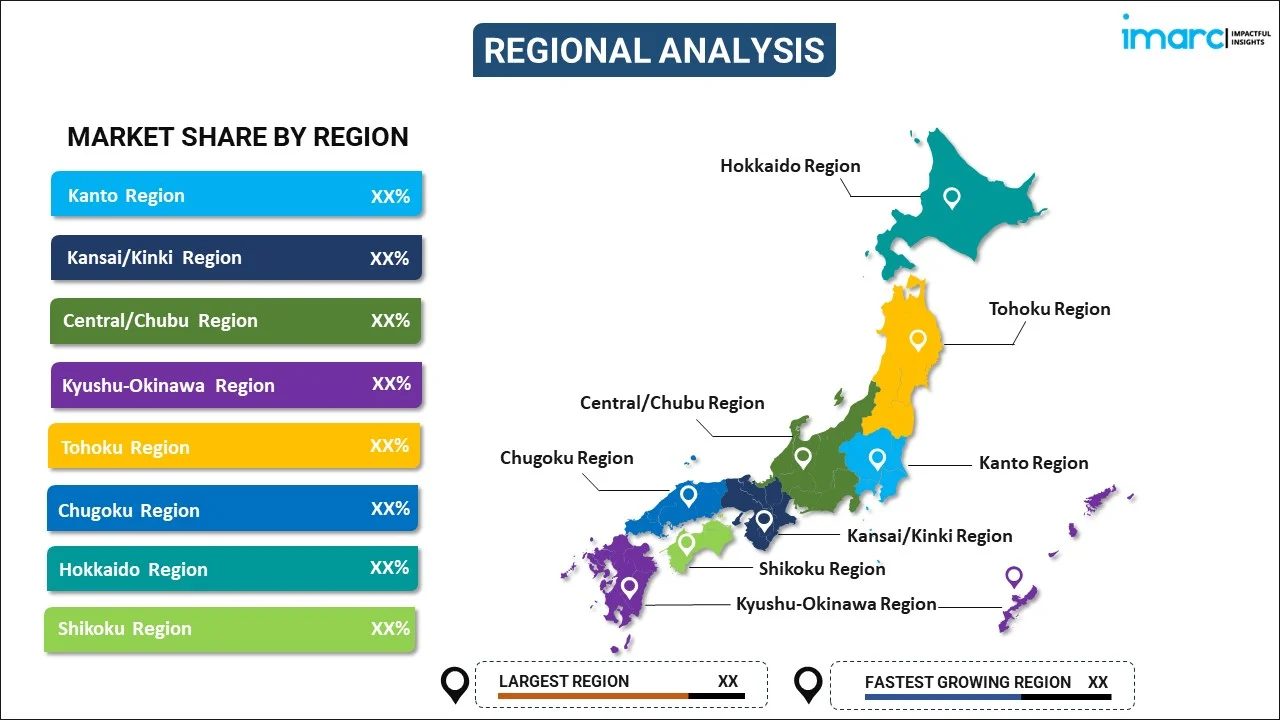
Japan Mass Spectrometry Market Report by Technology (Triple Quadrupole (Tandem), Quadrupole TOF (Q-TOF), FTMS (Fourier Transform Mass Spectrometry), Quadrupole, Time-of-Flight (TOF), ION Trap, and Others), Application (Pharmaceuticals, Biotechnology, Chemical and Petrochemicals, Environmental Testing, Food and Beverage Testing, and Others), and Region 2026-2034
Market Overview:
Japan mass spectrometry market size reached USD 430.4 Million in 2025. Looking forward, IMARC Group expects the market to reach USD 680.7 Million by 2034, exhibiting a growth rate (CAGR) of 5.23% during 2026-2034. The expanding pharmaceutical and biotechnology sectors, which rely heavily on mass spectrometry for drug development, quality control, and regulatory compliance, is primarily driving the market.
|
Report Attribute
|
Key Statistics
|
|---|---|
|
Base Year
|
2025
|
|
Forecast Years
|
2026-2034
|
|
Historical Years
|
2020-2025
|
|
Market Size in 2025
|
USD 430.4 Million |
|
Market Forecast in 2034
|
USD 680.7 Million |
| Market Growth Rate 2026-2034 | 5.23% |
Mass spectrometry refers to a powerful analytical technique used in chemistry and biology to identify and quantify molecules based on their mass-to-charge ratio. It works by first ionizing a sample, turning its molecules into charged particles, and then separating these ions according to their mass in a mass spectrometer. The process involves three main steps: ionization, mass analysis, and detection. In ionization, the sample is bombarded with high-energy electrons or subjected to other ionization methods, causing it to lose or gain electrons and become ions. These ions are then accelerated into a mass analyzer, where they are sorted based on their mass-to-charge ratio, creating a spectrum of ion intensities. Finally, the ions are detected, and the resulting data is used to determine the composition, structure, and quantity of the molecules in the sample. Mass spectrometry finds applications in various fields, including chemistry, biochemistry, environmental science, and forensics, enabling researchers to analyze complex mixtures, identify unknown compounds, and study molecular structures with high precision and sensitivity.
Japan Mass Spectrometry Market Trends:
The mass spectrometry market in Japan is experiencing robust growth due to several key drivers. Firstly, advancements in analytical techniques have fueled the demand for mass spectrometry instruments. Moreover, the increasing prevalence of complex diseases like cancer and the need for precise diagnostics have led to greater adoption of mass spectrometry in clinical research and healthcare, serving as a catalyst for market expansion. Additionally, the expanding pharmaceutical and biotechnology sectors have heightened the demand for mass spectrometers in drug discovery and development, further propelling market growth. Apart from this, the burgeoning interest in proteomics and metabolomics research to decipher intricate biological processes has amplified the utilization of mass spectrometry. The ability to provide accurate and high-throughput analysis of biomolecules has made mass spectrometry an indispensable tool in life sciences research. Moreover, stringent regulations and quality control standards in various industries, such as food and environmental monitoring, have driven the need for precise analytical techniques, leading to increased adoption of mass spectrometry systems. In conclusion, a convergence of factors, including technological advancements, healthcare demands, scientific research needs, and regulatory requirements, is expected to drive the mass spectrometry market in Japan.
Japan Mass Spectrometry Market Segmentation:
IMARC Group provides an analysis of the key trends in each segment of the market, along with forecasts at the country level for 2026-2034. Our report has categorized the market based on technology and application.
Technology Insights:

- Triple Quadrupole (Tandem)
- Quadrupole TOF (Q-TOF)
- FTMS (Fourier Transform Mass Spectrometry)
- Quadrupole
- Time-of-Flight (TOF)
- ION Trap
- Others
The report has provided a detailed breakup and analysis of the market based on the technology. This includes triple quadrupole (tandem), quadrupole TOF (Q-TOF), FTMS (fourier transform mass spectrometry), quadrupole, time-of-flight (TOF), ION trap, and others.
Application Insights:
- Pharmaceuticals
- Biotechnology
- Chemical and Petrochemicals
- Environmental Testing
- Food and Beverage Testing
- Others
A detailed breakup and analysis of the market based on the application have also been provided in the report. This includes pharmaceuticals, biotechnology, chemical and petrochemicals, environmental testing, food and beverage testing, and others.
Regional Insights:

- Kanto Region
- Kansai/Kinki Region
- Central/ Chubu Region
- Kyushu-Okinawa Region
- Tohoku Region
- Chugoku Region
- Hokkaido Region
- Shikoku Region
The report has also provided a comprehensive analysis of all the major regional markets, which include Kanto Region, Kansai/Kinki Region, Central/ Chubu Region, Kyushu-Okinawa Region, Tohoku Region, Chugoku Region, Hokkaido Region, and Shikoku Region.
Competitive Landscape:
The market research report has also provided a comprehensive analysis of the competitive landscape in the market. Competitive analysis such as market structure, key player positioning, top winning strategies, competitive dashboard, and company evaluation quadrant has been covered in the report. Also, detailed profiles of all major companies have been provided.
Japan Mass Spectrometry Market Report Coverage:
| Report Features | Details |
|---|---|
| Base Year of the Analysis | 2025 |
| Historical Period | 2020-2025 |
| Forecast Period | 2026-2034 |
| Units | Million USD |
| Scope of the Report | Exploration of Historical Trends and Market Outlook, Industry Catalysts and Challenges, Segment-Wise Historical and Future Market Assessment:
|
| Technologies Covered | Triple Quadrupole (Tandem), Quadrupole TOF (Q-TOF), FTMS (Fourier Transform Mass Spectrometry), Quadrupole, Time-of-Flight (TOF), ION Trap, Others |
| Applications Covered | Pharmaceuticals, Biotechnology, Chemical and Petrochemicals, Environmental Testing, Food and Beverage Testing, Others |
| Regions Covered | Kanto Region, Kansai/Kinki Region, Central/ Chubu Region, Kyushu-Okinawa Region, Tohoku Region, Chugoku Region, Hokkaido Region, Shikoku Region |
| Customization Scope | 10% Free Customization |
| Post-Sale Analyst Support | 10-12 Weeks |
| Delivery Format | PDF and Excel through Email (We can also provide the editable version of the report in PPT/Word format on special request) |
Key Questions Answered in This Report:
- How has the Japan mass spectrometry market performed so far and how will it perform in the coming years?
- What has been the impact of COVID-19 on the Japan mass spectrometry market?
- What is the breakup of the Japan mass spectrometry market on the basis of technology?
- What is the breakup of the Japan mass spectrometry market on the basis of application?
- What are the various stages in the value chain of the Japan mass spectrometry market?
- What are the key driving factors and challenges in the Japan mass spectrometry?
- What is the structure of the Japan mass spectrometry market and who are the key players?
- What is the degree of competition in the Japan mass spectrometry market?
Key Benefits for Stakeholders:
- IMARC’s industry report offers a comprehensive quantitative analysis of various market segments, historical and current market trends, market forecasts, and dynamics of the Japan mass spectrometry market from 2020-2034.
- The research report provides the latest information on the market drivers, challenges, and opportunities in the Japan mass spectrometry market.
- Porter's five forces analysis assist stakeholders in assessing the impact of new entrants, competitive rivalry, supplier power, buyer power, and the threat of substitution. It helps stakeholders to analyze the level of competition within the Japan mass spectrometry industry and its attractiveness.
- Competitive landscape allows stakeholders to understand their competitive environment and provides an insight into the current positions of key players in the market.
Need more help?
- Speak to our experienced analysts for insights on the current market scenarios.
- Include additional segments and countries to customize the report as per your requirement.
- Gain an unparalleled competitive advantage in your domain by understanding how to utilize the report and positively impacting your operations and revenue.
- For further assistance, please connect with our analysts.
 Request Customization
Request Customization
 Speak to an Analyst
Speak to an Analyst
 Request Brochure
Request Brochure
 Inquire Before Buying
Inquire Before Buying




.webp)




.webp)












